Take a moment to unwind and recharge with this guided meditation designed specifically for deep relaxation. This session will help you release tension and clear your mind, allowing you to reconnect with a sense of calm and peace. Settle in, let go of your worries, and allow your body and spirit to embrace tranquility.
Visualization for Tranquility
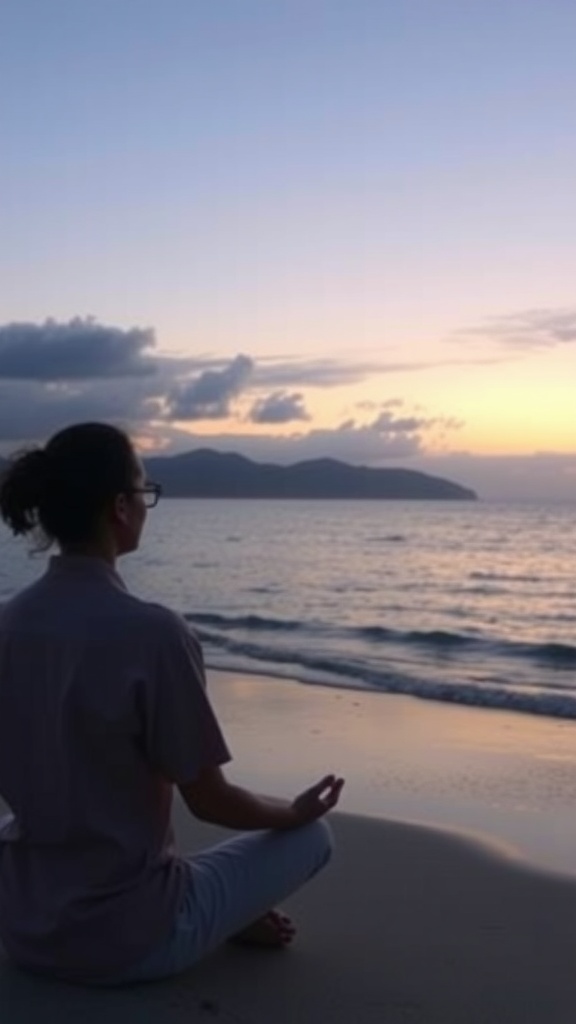
Imagine yourself sitting by the beach, just like the person in the image. They are perched comfortably on the warm sand, gazing out at the gentle waves. The sun is setting, painting the sky with soft hues of orange and pink. This serene setting is perfect for guided meditation and deep relaxation.
As you visualize this scene, take a deep breath in. Feel the cool breeze brushing against your skin, and listen to the soothing sound of the waves. Each wave that rolls in is a reminder to let go of your worries. With every exhale, release any tension you may be holding onto.
Picture yourself immersed in this tranquil atmosphere. The calming colors of the sunset reflect peace and stillness. This is your moment to connect with your inner self. Allow your mind to drift, focusing on the beauty around you and finding solace in the simplicity of the moment.
In your mind’s eye, see the horizon where the sky meets the sea. Let this image anchor you as you practice mindfulness. Each time you meditate, return to this peaceful beach, and invite the feelings of tranquility into your life. The more you visualize this scene, the easier it becomes to access that calmness whenever you need it.
Body Scan Meditation
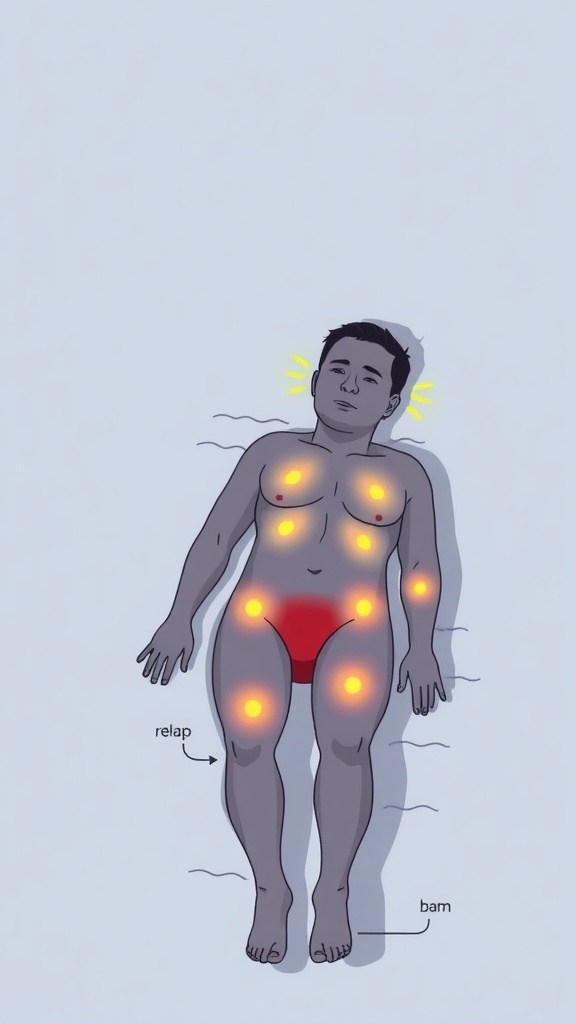
Body scan meditation is a simple yet effective practice for promoting relaxation. The image illustrates a person lying comfortably, which is a key position for this technique. As you settle in, you can focus on different parts of the body, releasing tension and enhancing your awareness.
The glowing dots around the body indicate areas of attention. These highlights remind you to concentrate on specific spots, like your chest, arms, and legs. By visualizing warmth or light in these areas, you can encourage relaxation and mindfulness.
As you practice body scan meditation, take your time to breathe deeply. Inhale through your nose, allowing your abdomen to rise, and then exhale slowly. This rhythm helps to ground you and deepen your relaxation.
Don’t rush through the process; instead, savor each moment. Allow yourself to connect with how your body feels, both physically and emotionally. It’s all about tuning in and being present.
Chakra Balancing Meditation
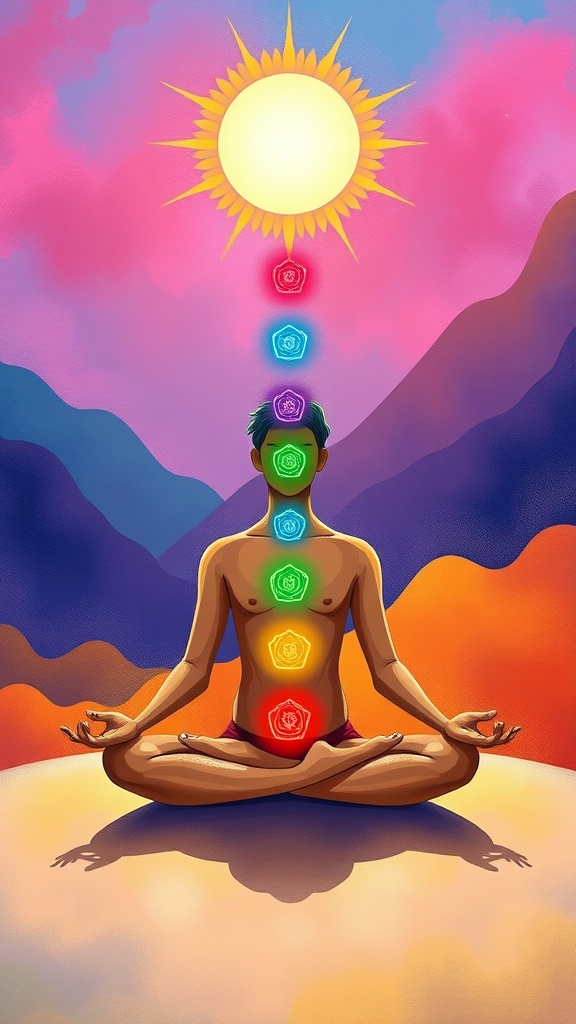
The image beautifully illustrates the concept of chakra balancing meditation. In the center, a person sits cross-legged, radiating a sense of calm and peace. The vibrant colors of the chakras align with their respective positions on the body, creating a visual guide for meditation.
Above the individual, a bright sun symbolizes energy and vitality, suggesting a connection between the physical and spiritual realms. The surrounding mountains and soft colors in the background enhance the feeling of serenity, inviting one to explore inner balance.
This meditation focuses on harmonizing the seven chakras, or energy centers, within the body. Each chakra plays a unique role in our overall well-being. Taking a moment to visualize each chakra can help in releasing tension and promoting relaxation.
As you engage in this practice, you can imagine each chakra glowing brightly, promoting a sense of alignment and flow. This simple but effective approach encourages mindfulness, helping you to connect with your inner self and find peace.
Loving-Kindness Meditation
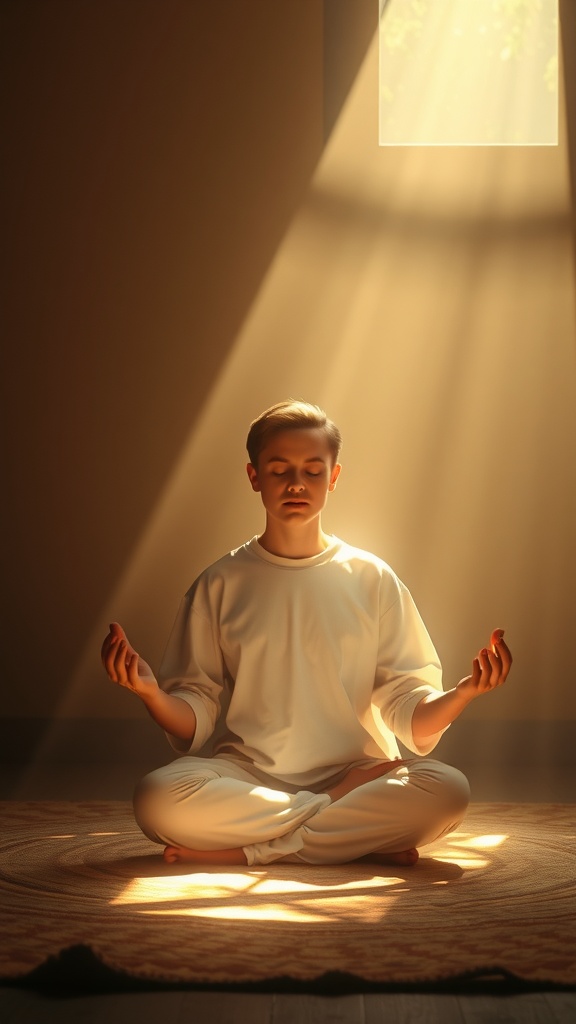
Loving-Kindness Meditation is a beautiful practice that helps cultivate compassion for yourself and others. In the image, we see a person sitting peacefully, surrounded by warm light. This serene setting perfectly captures the essence of this meditation style.
The soft rays coming through the window create a calming atmosphere, inviting a feeling of safety and warmth. Just like this light, Loving-Kindness Meditation encourages us to shine compassion into our hearts and the hearts of those around us.
When practicing, you begin by focusing on yourself, repeating phrases of kindness and love. As you settle into the moment, you gently expand these wishes to friends, family, and eventually even those you may find challenging. This gradual expansion fosters a deep connection with everyone around you.
This image reflects the inner peace that can come from such practice. The peaceful expression on the person’s face shows how powerful Loving-Kindness Meditation can be in promoting relaxation and harmony within. It’s a perfect reminder to take a moment for self-care and nurture positive feelings.
Breath Awareness Technique
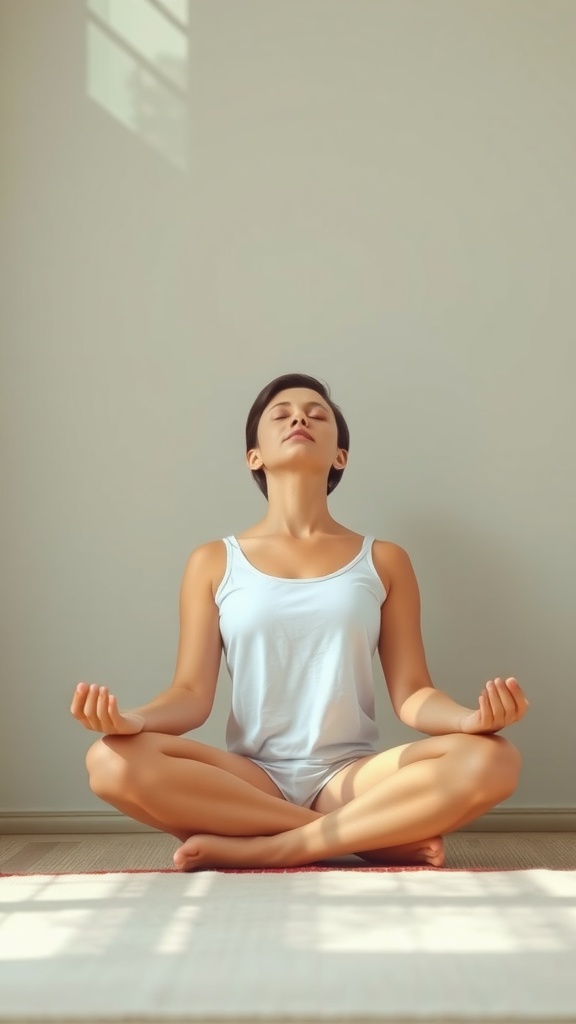
In the image, we see a person sitting cross-legged in a calm and serene environment. The soft lighting and the simplicity of the space create a peaceful atmosphere, perfect for meditation. This setting highlights the focus on breath awareness, an essential part of guided meditation for deep relaxation.
The breath awareness technique encourages us to pay close attention to our breathing patterns. It allows us to anchor ourselves in the present moment, helping to clear our minds from distractions. As you inhale deeply, feel the air fill your lungs. Notice how your body expands. Then, as you exhale, feel the release of tension.
Incorporating this technique into your meditation practice is simple. Start by finding a comfortable position, just like the individual in the image. Close your eyes and take a deep breath in through your nose, counting to four. Hold your breath for a moment, and then exhale slowly through your mouth, counting to six. Repeat this cycle several times.
With each breath, allow yourself to become more relaxed. Visualize your breath as a gentle wave, washing over you, bringing peace with each inhale and releasing stress with every exhale. This practice not only calms the mind but also connects us to our bodies, promoting a sense of well-being.
Nature Soundscapes for Deep Relaxation

Imagine sitting peacefully by a gentle stream, the soft sound of water flowing around you. This serene setting is perfect for meditation and relaxation. When you close your eyes, you can almost hear the leaves rustling in the breeze and birds chirping nearby.
The image captures a moment of tranquility. A person sits calmly on the smooth stones, surrounded by lush greenery. This kind of environment can help ground you, making it easier to let go of stress.
Listening to nature soundscapes is a wonderful way to enhance your meditation practice. The soothing sounds of water, wind, and birds can transport your mind to a peaceful place. You might find that these sounds create a backdrop that helps you focus and relax more deeply.
Next time you meditate, consider integrating nature sounds. You can find recordings online or simply step outside. Nature has a way of calming the mind and refreshing the spirit, making it an excellent companion for your relaxation journey.
Guided Imagery for Stress Relief

In this serene scene, we see a person sitting peacefully on a rock, surrounded by a lush forest. Soft rays of sunlight filter through the trees, creating a warm and inviting atmosphere. The gentle flow of a nearby stream adds a soothing sound that can enhance relaxation.
This image perfectly captures the essence of guided imagery for stress relief. When we visualize such calming environments during meditation, it helps to lower our stress levels and brings a sense of tranquility. By focusing on the details—the sound of the water, the feel of the cool breeze, and the sight of light streaming through the leaves—we can transport ourselves to a place of peace.
Guided imagery is a simple yet effective technique. It encourages us to use our imagination to create a mental escape from the daily grind. Try to picture yourself in a similar setting, allowing the sights and sounds to wash over you. This practice can be a valuable tool in your relaxation toolkit.
Mindfulness and Present Moment Awareness
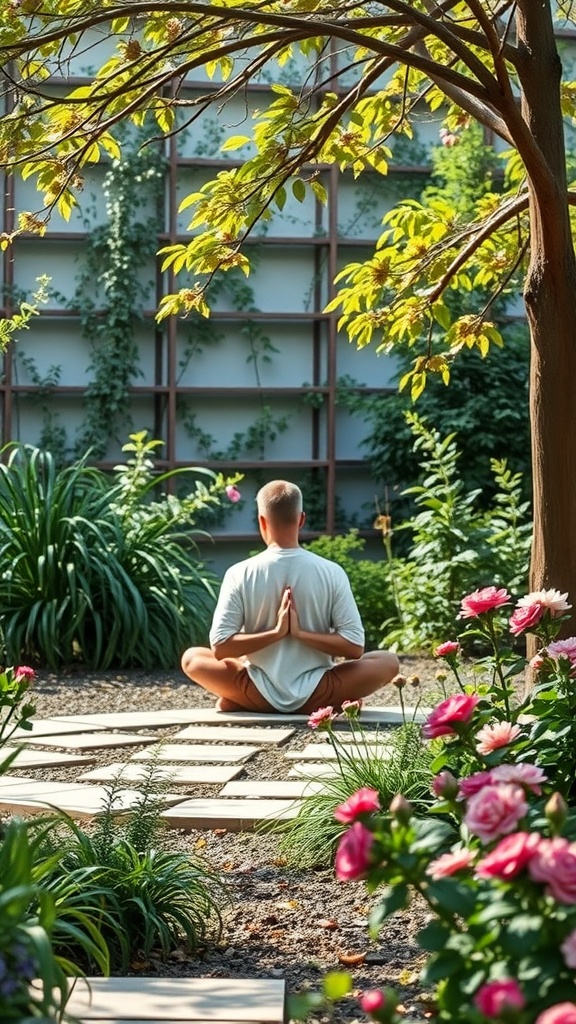
In this serene image, we see a person sitting peacefully in a lush garden, surrounded by vibrant flowers and greenery. Their posture is relaxed yet focused, hands resting in a prayer position. This visual encapsulates the essence of mindfulness, inviting us to pause and appreciate the present moment.
Mindfulness is about being fully engaged with what is happening right now. It encourages us to step away from the chaos of daily life and find a quiet space, just like the one depicted here. The garden setting is perfect for cultivating this awareness, as nature often helps ground our thoughts and feelings.
As you embark on this guided meditation for deep relaxation, take a moment to reflect on the beauty around you. Notice the colors of the flowers and the gentle rustle of leaves in the breeze. This connection to nature enhances our ability to remain present and aware, making meditation a more enriching experience.
By focusing on your breath and the sensations in your body, you can deepen your practice. Embrace the stillness and let go of distractions, just as the person in the image appears to do. Allow yourself to be present, letting go of worries about the past or future.
Progressive Muscle Relaxation
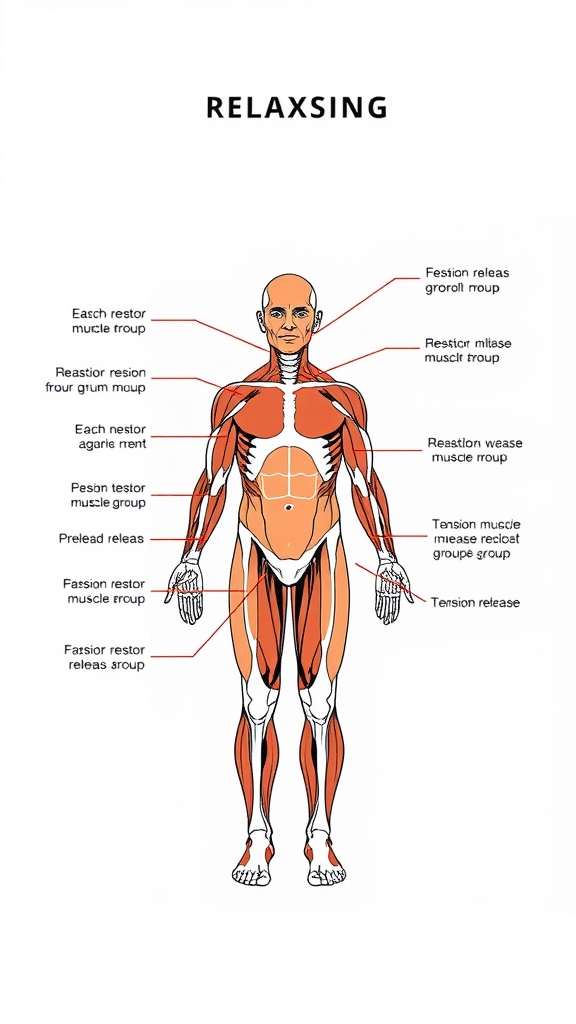
Progressive Muscle Relaxation (PMR) is a simple practice that helps to ease tension in your body. The image illustrates the various muscle groups involved in this technique. By focusing on each muscle group, you can learn to recognize and release tension effectively.
When you practice PMR, you systematically tense and then relax each part of your body. This process not only helps to relieve physical tension but also promotes a sense of calm and relaxation in your mind. The diagram shows where to direct your focus, starting from your head down to your toes.
Begin by finding a quiet space where you can sit or lie down comfortably. As you proceed through each muscle group shown in the image, take a deep breath, tense the muscle for a few seconds, and then exhale while letting go of the tension. Notice how your body feels after releasing each muscle group. This awareness is key to deep relaxation.
Practicing PMR regularly can improve your overall well-being. It can help reduce stress, improve sleep quality, and enhance your ability to manage anxiety. Take a few minutes each day to engage in this practice, and you may find that it makes a big difference in how you feel.